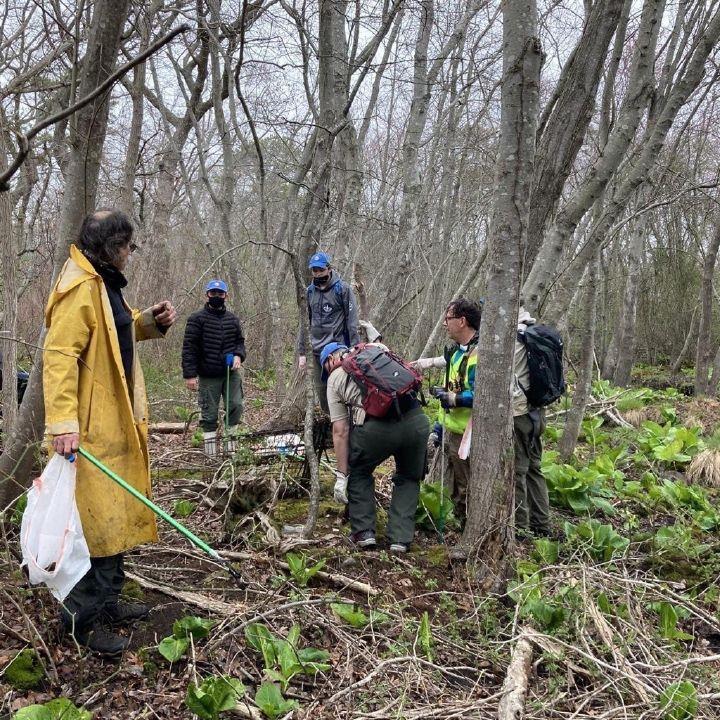Keeping an eye on the six waterways that empty into the Great South Bay from the Mastic Peninsula is Creek Defender Walter Meshenberg, a Marine Corps. veteran and volunteer ambulance driver who’s dedicated to protecting the area’s natural resources.
Working under the auspices of Save the Great South Bay, Meshenberg is on the front line of the region’s water crisis where the creeks he patrols are under the constant threat of pollution and habitat destruction. Draining from the densely-populated and low lying peninsula, the creeks–John’s Neck, Lawrence, Pattersquash, Sheepen, Sheepshead, and Unchachoque - are vital components of the region’s ecosystem. Monitoring the water quality of these backwaters and maintaining their health has become a passion for the Creek Defender.
“I’m out there every day, taking water samples and picking up litter,” Meshenburg said of his daily activities. “The creeks are under a lot of stress; they need someone to watch over them, take care of them.”
 |
|
Volunteers remove litter under the watchful eye of Creek
Defender Walter Meshenberg.
|
The Creek Defender, one of 20 who protect the Great South Bay, is active with educational outreach efforts to make sure new generations appreciate the area’s biodiversity and the need for environmental advocacy. “Community involvement has been fantastic as we work to make our local waterways cleaner and more vibrant,” Meshenberg said. “They understand the impact these tributaries have on the Great South Bay and the rest of the natural resources that make our area so desirable.”
Running the length of the William Floyd Estate, Lawrence Creek is the longest of the waterways the Defender takes care of. Pattersquash meanders up past Brookhaven’s Bayview Park, the former location of the hospital where Meshenberg was born, and actually crosses under Neighborhood Road at its beginning in the Mastic Beach business district. It is the widest of the area’s creeks and separates the two main branches of the peninsula. Sheepen Creek serves as the basin for the Mastic Beach Property Owners Association marina. Wetlands surrounding the creeks serve a vital function as filters and incubators for marine life. “It is essential that we protect them,” Meshenberg said, noting that the construction of long-awaited sewers will go a long way toward keeping the creeks healthy.
The marshes and tidal flats are flooded twice daily by the tides and serve as a major spawning ground for shellfish and finfish, including winter flounder, summer flounder, menhaden, weakfish and scup, according to the Nature Conservancy. The area is also an important stopover for migratory birds, as well as home to year-round species. With an abundance of oysters, scallops, quahogs, and soft shell clams, the waters sustained ancient Americans and played a key role in the country’s colonial history. The creeks are a breeding ground for menhaden, or bunker fish, which have made such a great recovery on Long Island that they’re seen as responsible for the resurgence of the ospreys and eagles that feed on them.
Trails and parklands ring the creeks and Meshenberg stays vigilant in keeping them clean. “We have a rapid response to illegal dumping and work with the town and Suffolk police to make sure the areas are guarded. There are many eyes out there watching,” he said.
“The Great South Bay will only be as healthy as the creeks and rivers that flow into it,” said Tom Kain, Creek Defender chairperson. “There are some 50 creeks that flow into the bay along the 16 communities along the South Shore,” he continued. “The Creek Defender Program calls upon people in each of those communities to become local stewards, healing our creeks as we heal the bay. They are led by Creek Defenders who act as local stewards, organizing and guiding their communities, leading cleanups, habitat restoration projects, and native planting initiatives. They spread our message that our care for the bay begins on the land, and the quality of that water entering the bay.”
Save the Great South Bay is active in restoring the local oyster population, a mollusk whose method of feeding filters enormous amounts of pollutants from the water. Through the filtering and keeping out nitrogen from land-borne fertilizer and septic systems, the harmful algae blooms that have plagued the bay can be eliminated.
